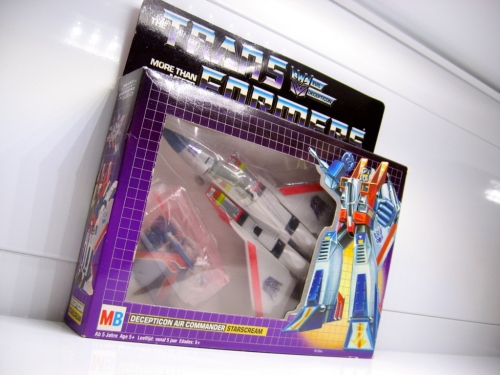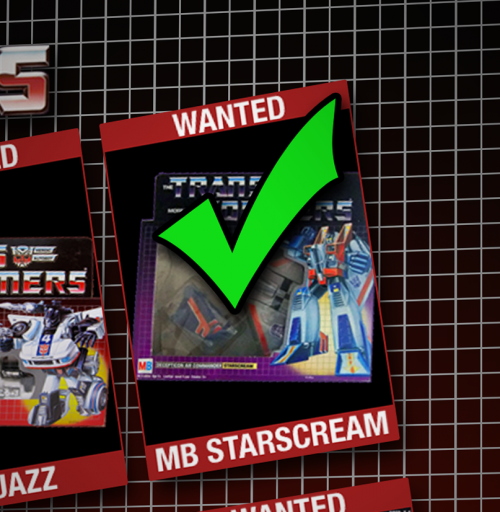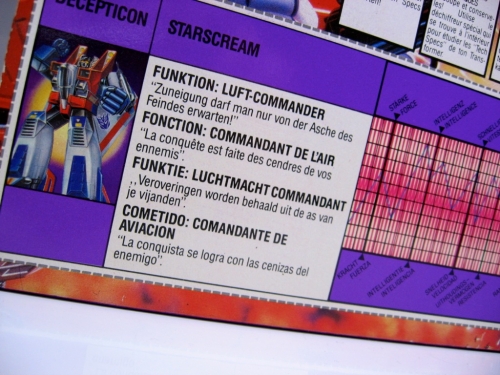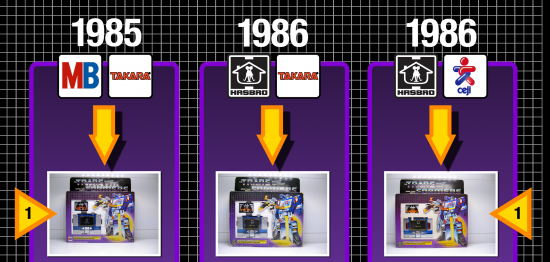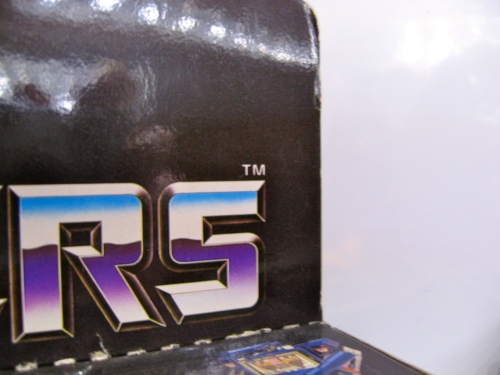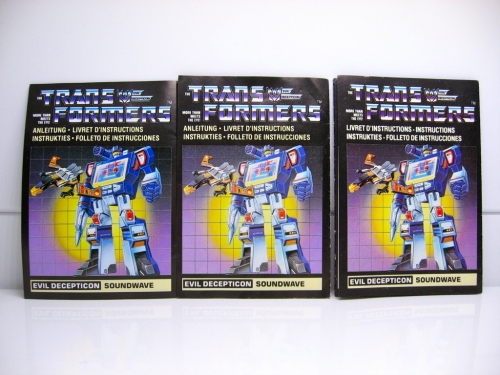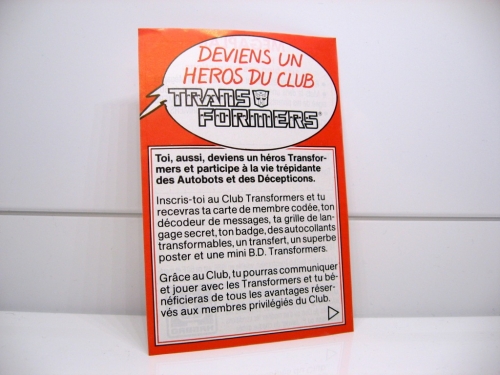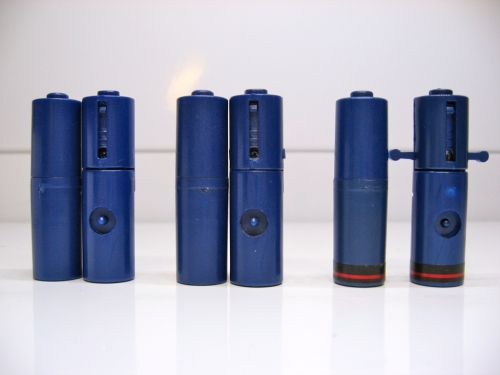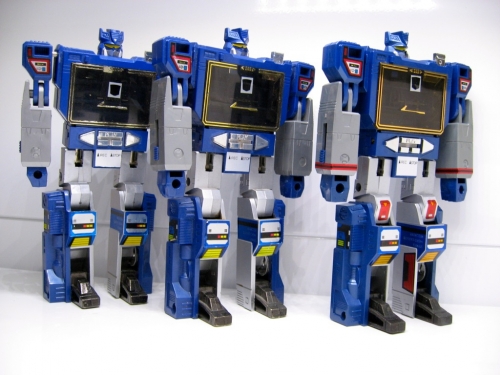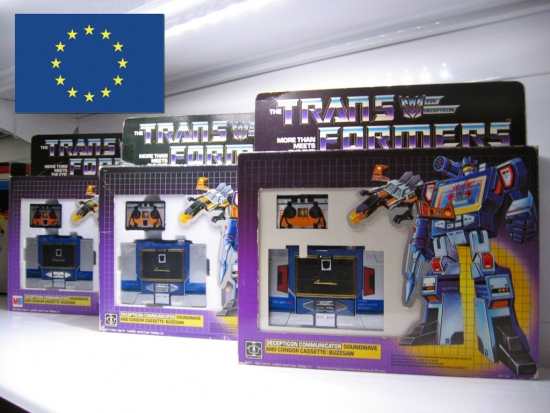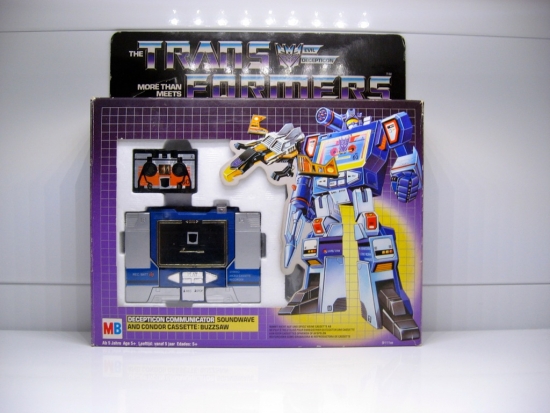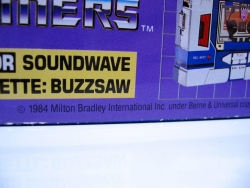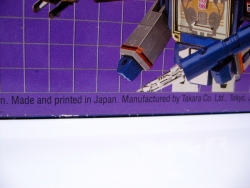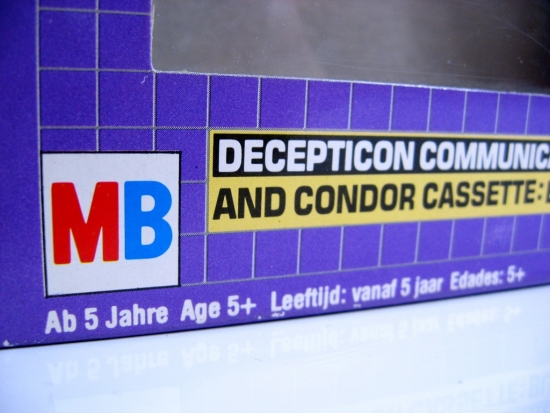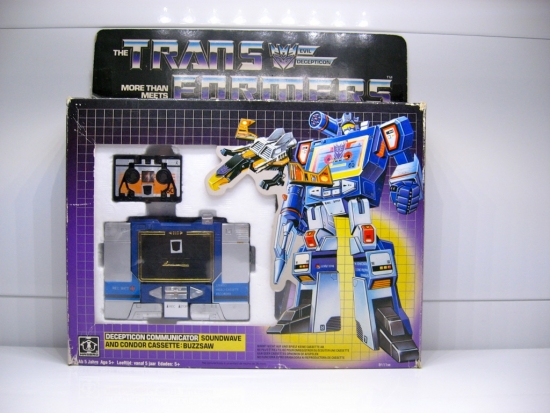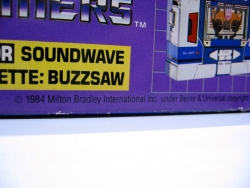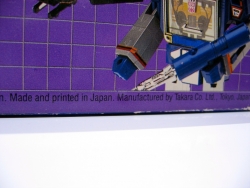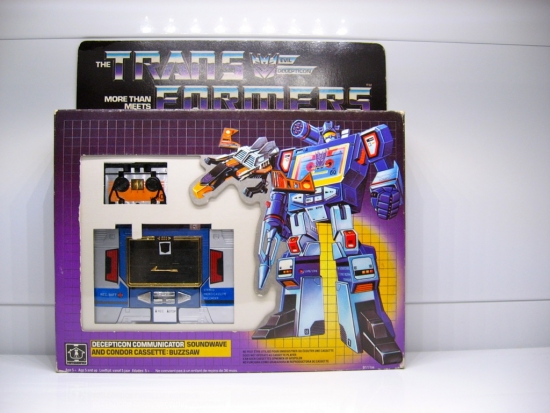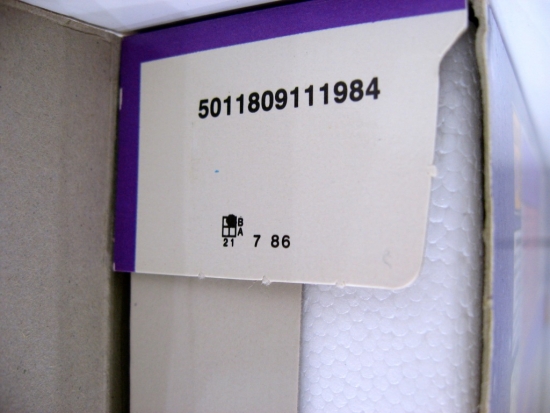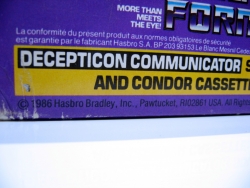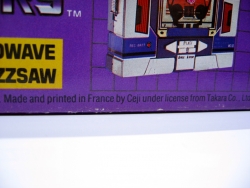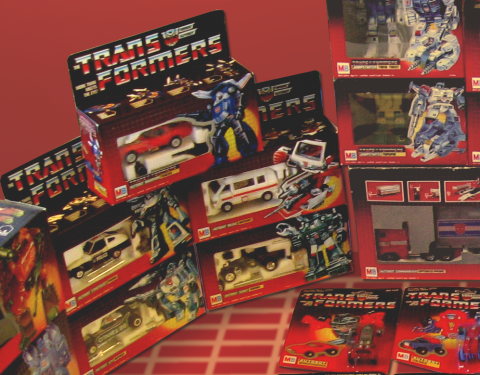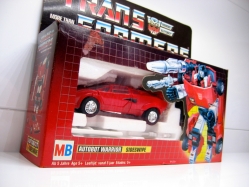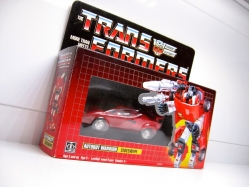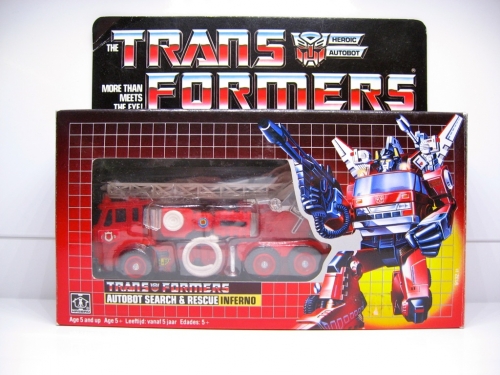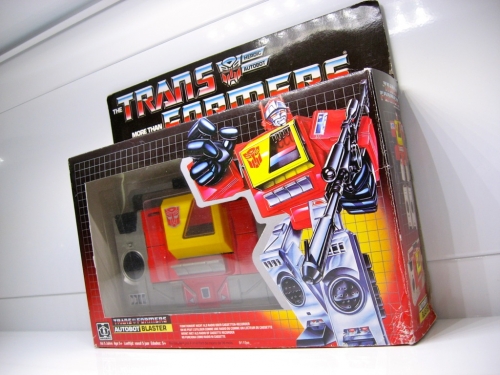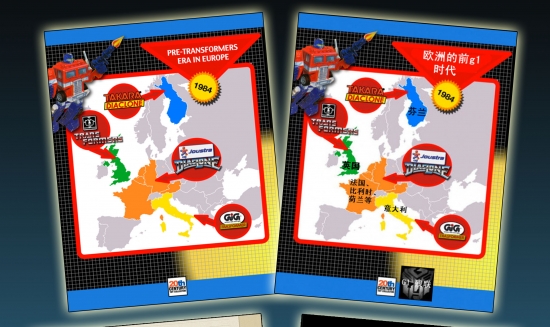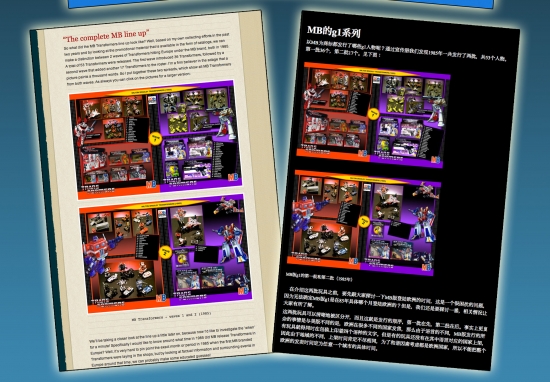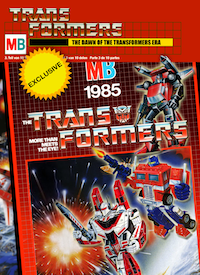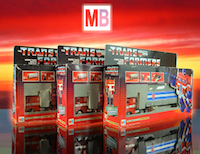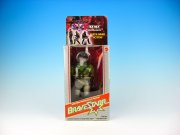Last week we had a first look at the three different versions of Soundwave that were released in Europe in 1985 and 1986. This week the conclusion where he have a more detailed look. I decided to embellish this second part with some new illustrations, which you will find below throughout the article. I might even merge these two parts into a more cohesive single article in the future. Enjoy reading!
“1. Packaging”
First a small visual recap of last week, where we primarily looked at packaging differences. Here’s an overall comparison of the front of the packaging. As always, you can click on the picture to open a bigger version.
1. The packaging
Also, all three variants have a trademark sign (™) next to the Transformers logo, which indicates the packaging is based on early American Soundwave packaging. Later versions of Transformers packaging in the US featured a registered trademark sign (®) next to the Transformers logo.
Trademark notice next to logo
“2. Tech Specs”
What I forgot to include last week was a shot of the back of the box, specifically of the tech specs. Here we can see again that the MB/Takara (1985) and Hasbro/Takara (1986) packaging is identical. Soundwave’s and Buzzsaw’s motto is shown in German, French, Dutch and Spanish respectively. The Hasbro/Ceji (1986) variant is different. Here we see that German has been dropped and replaced by English. Also, the Ceji variant has French as the first language and English as second. This is different from most of the other 1986 European Hasbro/Takara output where the order is swapped around with English as the first language, followed by French. This is not really surprising though, given the fact that both Soundwave’s box and the toy itself were printed and manufactured in France. Dutch and Spanish remain unaltered as third and fourth language on the Ceji Soundwave packaging.
2. The tech specs
“3. Logo and Age Notice”
The next thing to look out for when identifying European Soundwaves is the branding on the packaging. The MB/Takara version carries an MB logo on the box which is easily recognized. The Hasbro/Takara and Hasbro/Ceji versions, of course, feature a Hasbro logo. But there is a good way to tell the latter two apart. As we’ve seen above, the Hasbro/Ceji variant has a different set of languages compared to the Hasbro/Takara variant. Right under the MB or Hasbro logo is an age notice in four languages. The MB/Takara and Hasbro/Takara packaging has the exact same quad-lingual notice (German, French, Dutch and Spanish), while the Hasbro/Ceji version is different (French, English, Dutch and Spanish).
3. Logo and age notice
“4. Copyright Notice”
And the last thing we looked at last week was the copyright notice on the box. Again, the MB/Takara and Hasbro/Takara variants have identical packaging in this respect. The copyright notice shows 1984 as the year (while these variants were actually released in 1985 and 1986 respectively in Europe) and show “Milton Bradley International, Inc” as the copyright holder. The Hasbro/Ceji variant is different and shows a 1986 copyright belonging to “Hasbro Bradley, Inc.” Also, where the Takara variants were both made and printed in Japan, the Ceji variant was made in France and also had its packaging printed in France (by a company called Cajofe).
4. The copyright notice
A word of warning: It seems that a couple of years later (early 1990’s?) Chinese versions of Soundwave were made. The packaging these came in is nearly identical to the European Hasbro/Ceji packaging. The main difference is the copyright notice on the box, which only shows the first part (“© 1986 Hasbro Bradley, Inc.”) and has the part about being manufactured and printed in France missing. It looks like they just reused this original Hasbro/Ceji packaging and changed it slightly. This Chinese version may or may not also come with Chinese stickers on the box. It may also contain English language stickers, because it seems that these have been imported into the UK as well at some point in time. So, although that box looks like it’s European, it’s not a real European release.
“5. Styro Foam Patterns”
Now let’s shift our focus to the insides of the box! The moulding differences between these three Soundwaves are very minor, but there is one dead give away that will allow you to determine if you have a Ceji Soundwave or not. Before we get to the mould differences, there is one additional packaging detail that distinguishes the Ceji Soundwave from the Takara made Soundwaves. Both the MB/Takara and the Hasbro/Takara Soundwaves have identical styro foam inserts, with characteristic circles made up of small points all over the styro. See the first two photos from the left in the picture below. I deliberately tweaked the brightness and contrast to extremes in order to make the circles stand out. If you look at the styro foam that was used for the Hasbro/Ceji Soundwave you see differently styled circles, made up of evenly spaced straight lines/ridges. Since the Takara Soundwaves were both packaged in Japan they look the same. The Ceji Soundwave was made and packaged in France, which explains the different styro foam.
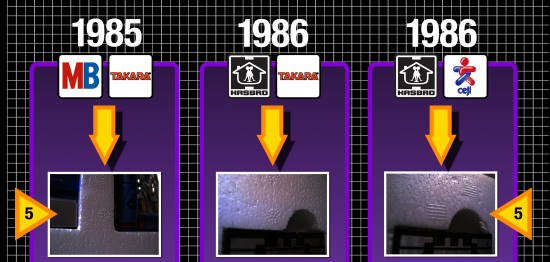
5. Styro foam patterns
“6. Copyright Stamping”
The best way to check if you have a true Ceji Soundwave is by looking at the copyright stamping on the toy itself. The MB/Takara and Hasbro/Takara Soundwaves were both made by Takara and as such have the same stamping, which you can see below. The Ceji Soundwave is a little different. It has the additional “MADE IN FRANCE” text above the original stamping and it has the word “JAPAN” blocked out.
6. Copyright stamping on toy
Another word of warning here. There is also a Mexican Soundwave, which was made a couple of years later by Mexican toy manufacturer IGA. There is a lot of evidence that suggests Ceji moulds were acquired by IGA at some point in time. These Mexican IGA Transformers will often have the word “JAPAN” blocked out as well and in some cases still have the “MADE IN FRANCE” notice added from the original Ceji moulds (e.g. the Mexican IGA Megatron has a “MADE IN FRANCE” stamping) even though the toy was not made in France. I am not sure what the exact copyright stamp is on a Mexican Soundwave, but there’s an easy way to identify a Mexican Soundwave: its feet are painted black!
“7. Belt Clip”
There’s another mould variation that’s easily spotted and that’s on the belt clip. Now, because this is a detachable item, it is theoretically possible for someone to swap them. So you should always be careful drawing conclusions about a toy’s origins based on characteristics of detachable parts like these. With that caveat out of the way, you can clearly see a difference between the Takara Soundwaves and the Ceji Soundwave. The Takara belt clips have three small ridges running through the center of the bottom of the clip. The Ceji belt clips are smooth and have no ridges there.
7. The belt clip
“8. Fists”
I’ve been pondering whether to include this or not, since it is such a minor detail. Often little differences like these can occur during minor mould changes or because of mould wear during the production process, so just because your Soundwave does not have these, doesn’t mean it’s not specifically a Takara or Ceji. So, take this one with a grain of salt. As you can see from the photos below, the Takara Soundwaves have a pretty smooth fist. The Ceji fist is a little different. It has two circular holes which are clearly visible from up close.
8. Fists
“Instructions”
The instruction booklets included with these European Soundwaves are all quad-lingual. As you might expect, there is a difference again between the MB/Takara, Hasbro/Takara instructions and the Hasbro/Ceji instructions. Both the MB/Takara and the Hasbro/Takara version have the same instructions that were originally produced for the MB release. These feature German, French, Dutch and Spanish as the four languages. The Hasbro/Ceji version comes with a different set of languages: French, English, Dutch and Spanish.
Soundwave – European instructions
The Hasbro/Ceji Soundwave also came packaged with a mini leaflet , all in French, with instructions on how to join the French Transformers Club.
Hasbro/Ceji Soundwave – French Transformers Club leaflet
“Battery”
One of the batteries of my particular Ceji Soundwave has two pieces of plastic sticking out from the sides. It looks like it’s a left over from the production process and not necessarily a variation point. I thought it would be good to include it here anyway, because maybe someone recognizes it.
Soundwave batteries (MB/Takara, Hasbro/Takara and Hasbro/Ceji)
“Missing Rub Sign on Buzzsaw”
There’s another oddity with the Ceji Soundwave that I didn’t feel worth mentioning initially and that is that Buzzsaw has no rub sign. I thought nothing of it, but very recently I saw an eBay auction for a very nice Ceji Soundwave and it also had the rub sign missing. I am not willing to go so far as to claim that this is the norm for all Ceji Soundwaves or even for a big number of them, but I did find it worth mentioning. I really should see more Ceji Soundwaves, preferably one found MISB (mint-in-sealed-box) to be able to say that with any degree of certainty.
“Overview”
So there were are! A relatively simple identification guide to vintage European Soundwaves. I make no claims as to the accuracy of all the information above (though I have no reason to believe the information is incorrect). This is just based on my own observations and personal research and you should treat it as such, just a guide. I will make an attempt to keep this article up to date whenever new information or errors come to light. To close things off, here’s a nice 2-page spread that contains all the 8 points we looked at. Please note: the resolution of the picture is pretty high so the file is very big, but that was necessary in order to preserve the details in some of the photos.
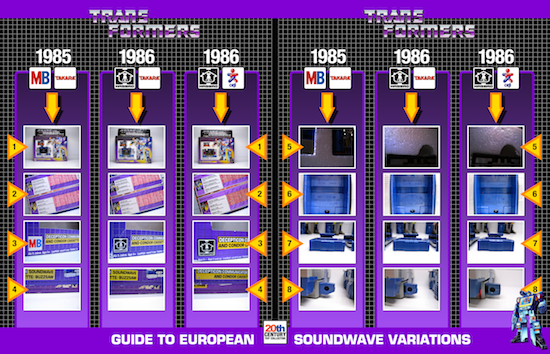
Left Soundwave to middle Soundwave: “Look at that piece of Euro trash in front of us.”
Right Soundwave: “Soundwave supérieure.”
Fin.


